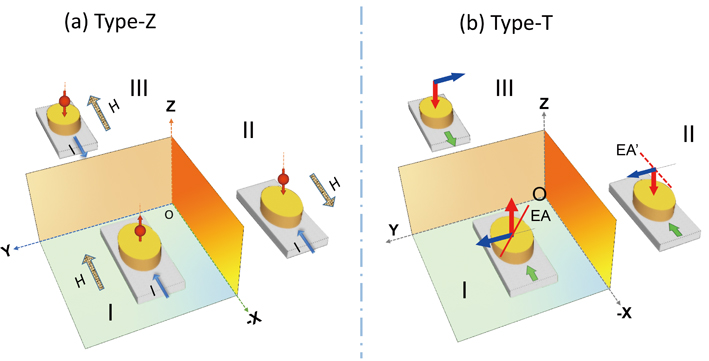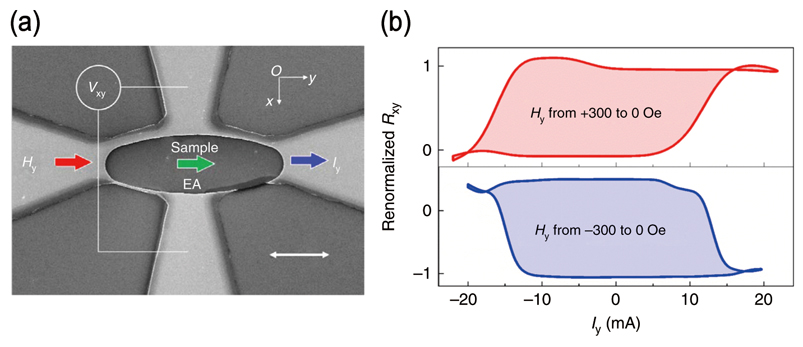It has long been a challenging goal to realize magnetization switching of magnetic films in zero field condition. Benefiting from the development of all-electrical magnetization switching methods over the past decades, magnetic random access memory (MRAM) has also been evolving generation by generation. Now MRAM has become one of the most promising candidates for next-generation non-volatile memory, in which magnetic tunnel junction (MTJ) plays the core role of a building block. For example, the first-generation MRAM is built on the basis of field driven MTJ where the Oersted field originating from the pulse current is employed to switch the magnetization of ferromagnetic layer and to accomplish the writing process. The second-generation MRAM is based on spin transfer torque (STT)-MTJ, adopting the STT from spin polarized current as the primary manner of information writing. The energy consumption of the STT-MRAM is thus significantly reduced, compared to that of the field-MRAM. Nowadays, the physics community is trying to establish the third-generation MRAM on the basis of spin-orbit torque (SOT) driven MTJ in which the read and write paths are separated to increase endurance and writing speed, and meanwhile minimize energy cost of the MRAM devices.
However, writing data in the SOT style into MTJ with perpendicular anisotropy (the elementary building block of a SOT-MRAM) is halted by an indispensable in-plane bias field when switching the perpendicular magnetization and fulfilling the writing tasks. So achieving field-free magnetization switching driven by SOT in MTJ with perpendicular anisotropy becomes the most important problem for the practical application of SOT-MRAM.
To resolve this scientifically challenging and practically frontier issue, Prof. HAN Xiufeng and colleagues at the Beijing National Laboratory for Condensed Matter Physics/Institute of Physics, Chinese Academy of Sciences (CAS) has developed a MgO/CoFeB/Ta/CoFeB/MgO structure with a T-type magnetic configuration in which one could realize double types of all-electrical magnetization switching modes: Type–z and Type–T mode. In the T-type magnetic configuration, a perpendicular CoFeB layer with tilted easy axis (EA) was coupled via a Ta spacer layer to an in-plane CoFeB layer with a uniaxial easy axis. This layered structure is inherently suitable to be inserted into MTJ as a free layer and could consequently enable the MTJs manipulatable by SOT in field-free condition ideally. In type-z mode, a current is applied along the EA of the layer with in-plane magnetic anisotropy (IMA), and the CoFeB layer with perpendicular magnetic anisotropy (PMA) could thus be switched by the interplay of SOT and the in-plane effective field resulting from the IMA layer. Furthermore, the SOT-switching chirality (clockwise or counterclockwise in magnetization vs. current curves) of the PMA layer can be controlled by the orientation of the IMA layer. In Type-T mode, first, it is notable that the EA of PMA layer tilts against perpendicular axis and forms a small angle between the EA of PMA layer and perpendicular axis (Figure 1b). A current applied along the in-plane hard axis of the IMA layer fails to switch the PMA layer alone. However, this manner enables the IMA layer switchable via SOT. Finally, both PMA and IMA layers could be switched simultaneously at the same critical current because of (1) the interlayer coupling effect mediated by the Ta spacer layer and (2) SOT provided also by the Ta layer. This novel switching mode is named as Type-T mode since it exists in the structure with a T-type magnetic configuration.

Figure 1. (a) The symmetric operation of Type-z mode; (b) The symmetric operation of Type-T mode. Both magnetization and magnetic field are pseudo-vectors.

Figure 2. (a) Structure of a patterned film based the SEM image of Hall Bar. (b) Field-free switching of the Hall bar. The switching chirality depends on the history of in-plane layer.
They have also studied the MgO/CoFeB/Ta/CoFeB/MgO structure in which two CoFeB layers with PMA are coupled with each other via a Ta spacer. The effective spin Hall angle is derived to be -0.1586 ± 0.013 using the harmonic measurement. And the magnetic properties show that CoFeB on top of the Ta layer can antiferromagnetically couple to the other beneath the Ta layer [1]. The Ta spacer layer could provide SOT and interlayer exchange coupling effect to switch the magnetization efficiently.
In conclusion, double types of field-free switching modes (Type-T and Type-z mode) realized in the MgO/CoFeB/Ta/CoFeB/MgO system with T-type magnetic configuration could advance the development of field-free SOT-MRAM and multifunctional spin logic devices. Besides, the core structure MgO/CoFeB/Ta/CoFeB/MgO was inherently compatible with current mainstream perpendicular-MRAM technology. Especially, the discovery of the Type-T mode shed light on the effective manipulation of magnetization in the complex structures [2].

Figure 3. (a) Scanning electron microscopy image of the measurement setup of the Type-T mode. (b) The switching loops driven by SOT in the condition of zero field and 300 Oe. (c) Dynamic switching simulation results of the Type-T mode. The red and blue paths show the switching dynamic process of PMA and IMA layers, respectively. The magnetization of PMA layer passes to position 2 from position 1 driven by SOT, then the energy of the system becomes increasingly unstable, finally the PMA layer will be switched at the same time when the IMA layer reverses.
This work has already been published in Nature communications [W. J. Kong, C. H. Wan, and X. F. Han et al, Nat. Comm. 10 (2019) 233]. This work was supported by the National Key Research and Development Program of China (MOST) and the National Natural Science Foundation of China (NSFC).
Link to the paper: https://www.nature.com/articles/s41467-018-08181-y
References
1. W. J. Kong, C. H. Wan, B. S. Tao, C. Fang, L. Huang, C. Y. Guo, M. Irfan, and X. F. Han. Study of spin-orbit torque induced magnetization switching in synthetic antiferromagnet with ultrathin Ta spacer layer. Appl. Phys. Lett. 113 (2018) 162402, Editors' pick.
2. W. J. Kong, C. H. Wan, X. Wang, B. S. Tao, L. Huang, C. Fang, C. Y. Guo, Y. Guang, M. Irfan, X. F. Han. Spin-orbit torque switching in a T-type magnetic configuration with current orthogonal to easy axes. Nat. Comm. 10 (2019) 233, Editors' Highlights.
(IOP)

